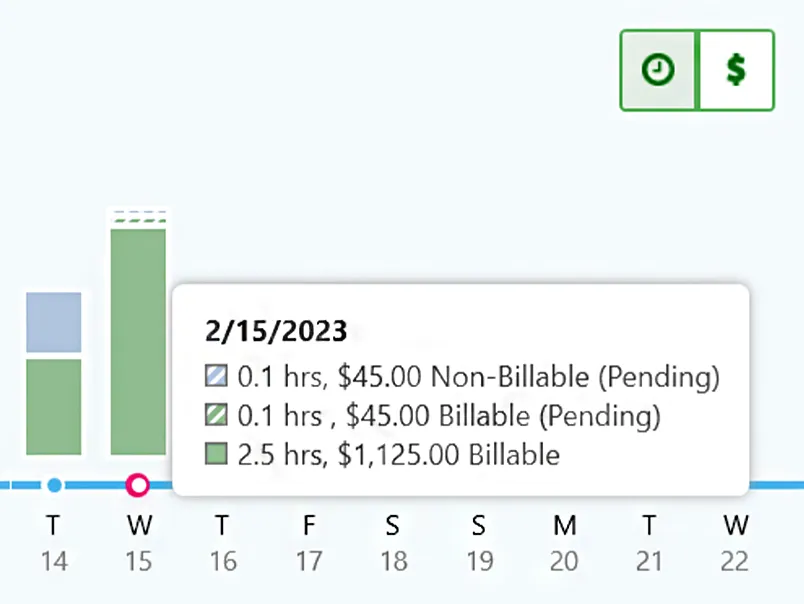Why Flat Fee Lawyers Are the Future: How to Make the Most of This Pricing Model
Written by
|
March 7, 2025
Written by Smokeball
|
March 7, 2025

Written by Jordan Turk
|
March 7, 2025

Flat fee pricing is shaking up the legal industry. Instead of charging by the hour, more and more lawyers are choosing flat fees to offer clients transparency and predictability. This shift is rapidly gaining traction as clients demand more clarity and convenience — and it’s clear that flat rate attorney fees are the future of law. In this blog, we’ll explore why this pricing model is becoming so popular, how it benefits lawyers, and how you can leverage it to streamline your practice, boost client satisfaction, and stay ahead in an increasingly competitive market.
What Is a Flat Fee for a Lawyer?
A flat fee pricing model in law means charging clients a fixed, predetermined amount for a specific service or case, regardless of the time it takes to complete. This can apply to a range of legal services, such as drafting a will, handling a divorce, or representing a client in a straightforward criminal case.
The key benefit? Clients know exactly what they’re paying upfront, which helps avoid surprises and foster trust. On the flip side, traditional hourly billing charges clients by the minute, with costs fluctuating depending on the case complexity. It’s a recipe for unpredictable bills, leaving clients hesitant to reach out for fear of watching the clock — and their budget—tick away.
Common Misconceptions About Flat Fee Structures
Many people misunderstand flat fee pricing in law, and this can stop lawyers from fully accepting this model. Here’s a breakdown of those misconceptions and the reality behind them:
- Misconception: Lawyers lose out on compensation with flat fees.
Reality: When structured properly, flat fees can be just as profitable, if not more, than hourly billing. By streamlining processes and handling cases more efficiently, lawyers can increase their profit margins. - Misconception: Flat rate attorney fees are only for simple cases.
Reality: Flat fees can work for both routine and complex cases. With clear scopes of work and an appropriate fee structure, even intricate legal matters can be handled on a flat fee basis. - Misconception: Flat fees mean cutting corners on quality or service.
Reality: A flat fee model doesn’t compromise quality. It simply allows lawyers to manage their time and resources more efficiently, providing clients with the same high-quality service without the fear of escalating costs. - Misconception: Flat fees are difficult to calculate and implement.
Reality: Setting a flat fee requires thoughtful planning. By defining the scope of services clearly and factoring in potential case complexities, flat fees can be easily implemented and adjusted to fit a lawyer’s practice.
Tackle these myths, and flat fee pricing can turn into a win-win for both lawyers and clients — no surprises, just solid results.

A Brief History Behind the Flat Fee Model in Law
Pre-1900s: Barter and Fixed Sums
Early Legal Fees:
- Lawyers were paid through barter or fixed sums for specific services (e.g., drafting contracts, wills).
- No standardized pricing model existed—clients and lawyers negotiated fees individually.
1900s - 1950s: The Rise of Hourly Billing
1940s-1950s: Hourly Billing Becomes Standard
- As cases became more complex, hourly billing was introduced to ensure lawyers were compensated for time spent on a case.
- Clients were charged based on the hours lawyers worked, regardless of the complexity or outcome of the case.
1960s - 1980s: Challenges with Hourly Billing
Rising Client Concerns
- Unpredictable Costs: Clients were frustrated with escalating fees, unsure of how long their case would take.
- Lack of Transparency: Clients had no clear insight into how their time was being billed, leading to distrust.
- Legal Fees as a Barrier: Many clients were discouraged from seeking legal help due to high, uncertain costs.
1990s: The Push for Transparency and Client-Focused Services
Growing Demand for Predictability
- Lawyers began recognizing the need for more transparent and predictable pricing.
- Clients wanted clear, upfront costs to avoid surprises, especially for routine services (e.g., wills, uncontested divorces).
- The flat fee model began gaining attention as an alternative to hourly billing.
2000s: Flat Fees Gain Popularity
Early 2000s: Flat Fees Gain Traction
- More lawyers offered flat fees for simple and routine legal services, like family law, estate planning, and real estate transactions.
- Flat fees became popular for small businesses and individual clients seeking clarity and affordability.
- Client Trust and Satisfaction: Flat fees helped build stronger client relationships by offering transparency and predictability.
2010s - Present: Flat Fees Become Mainstream
2010s: The Shift Toward Client-Centric Pricing
- Flat fees became widely accepted, and many law firms adopted them for a variety of cases.
- Technology tools helped streamline case management and flat fee billing, making it easier for lawyers to implement the model efficiently.
- Continued Growth: Flat fees are no longer just for simple cases—lawyers now offer them for more complex services, such as divorce and business formation.
Looking Ahead: The Future of Flat Fee Pricing
2020s and Beyond: Flat Fees as the Future of Law
- The shift from hourly billing to flat fees is expected to continue as clients demand even more transparency and value for their legal services.
- As more law firms embrace flat fees, the model is set to become a dominant pricing structure in the industry.

Flat Rate, Big Impact: Practice Areas That Thrive
Some practice areas in law are a natural fit for flat fees — thanks to their predictable, straightforward services that make pricing a breeze. Well, not exactly a breeze, but pretty close to it in the often-complicated world of law. Here are some key practice areas where flat fees can benefit both lawyers and clients:
Estate Planning
Flat fees work well for estate planning, including drafting wills, trusts, and handling simple estates. These services generally have a clear, defined scope, allowing lawyers to establish a fixed price for standard tasks. Clients appreciate knowing upfront what they’ll pay, and lawyers can efficiently complete routine documents without worrying about variable hourly costs.
Family Law
In family law, cases like uncontested divorces or straightforward child custody matters can be priced on a flat fee basis. The process is often predictable, allowing attorneys to provide clients with clarity around costs from the outset. This not only reduces client anxiety but also streamlines the attorney’s workflow by eliminating hourly billing disputes.
Real Estate Law
Contract reviews, property closings, and title checks are common real estate law services that work well with a flat fee model. These tasks are typically predictable in scope and time, making it easier to set a fixed price. Clients benefit from the simplicity and transparency of flat fees while lawyers can streamline their processes and reduce administrative burdens.
Criminal Defense
For simple misdemeanor cases, flat fees are an excellent fit. The scope of the work is typically clear, and clients appreciate knowing their total cost upfront. This helps lawyers avoid disputes in criminal law cases over time spent and helps provide a predictable revenue stream for routine cases.
Business Law
Business law, especially for small businesses and startups, is ideal for flat fees. Services like forming LLCs, drafting contracts, and handling basic compliance are typically obvious and uncomplicated. Flat fees cut through the confusion for clients and help lawyers work more efficiently. No more unpredictable hourly rates — just straightforward, consistent value for both parties.
In these practice areas, flat fees bring simplicity, transparency, and efficiency to the table — benefits that both clients and lawyers can appreciate.

Flat Fees: The Sweet Spot Between Profit and Peace of Mind
Switching to flat fee pricing isn’t just smart, it’s a game-changer for lawyers. You get financial stability, happy clients, and less stress about the clock ticking. Here are the key benefits:
- Predictable Income: Flat fees provide a steady cash flow, making it easier for lawyers to manage their finances and plan for the future. Instead of relying on the uncertainty of hourly billing, which can fluctuate depending on the complexity of cases and hours worked, flat fees offer a clear, upfront payment. This predictability helps lawyers maintain consistent revenue, making it easier to budget for expenses, staff salaries, and office overhead.
- Better Client Relations: Clients love transparency and flat fee pricing delivers just that. By offering a fixed rate for services, clients are no longer surprised by escalating costs or unsure about how much time their lawyer is spending on their case. This clarity builds client trust, making clients feel more comfortable with their lawyer and reducing potential conflicts over bills. When clients know exactly what they’ll be paying from the start, they are more likely to feel positive about the entire experience.
- Efficiency: Flat fee pricing encourages lawyers to work more efficiently because they no longer need to track every minute of their time. With a set price in mind, lawyers can focus on getting the work done as quickly and efficiently as possible, without worrying about how long each task will take. This leads to faster turnaround times and increased capacity, allowing lawyers to handle more cases without sacrificing quality.
- Attracting Clients: Flat rate attorney fees can make legal services more appealing, especially to price-conscious clients. Many clients seek out predictable pricing because they want to avoid the uncertainty of hourly rates. This pricing model can be an attractive option for clients who are wary of the escalating costs of hourly billing, making it easier for lawyers to attract new clients and grow their practices.
- Higher Client Satisfaction: The biggest benefit of flat fee pricing is the impact it has on client satisfaction. With clear expectations and no surprises, clients feel more confident in their legal services. This leads to higher levels of trust, which can translate into repeat business, referrals, and long-term relationships. Happy clients are your best marketing tool — they’ll send their friends your way, helping you build a client base without lifting a finger.
In short, flat fee pricing provides financial stability, strengthens client relationships, increases efficiency, and drives client satisfaction—making it a win-win for both lawyers and their clients.
Flat Fee Hiccups: How to Avoid the Bumps in the Road
While flat fee pricing offers plenty of perks, it’s not without its potential pitfalls. Here’s a rundown of the challenges lawyers might face — and how to tackle them with a little planning.
- Risk of Underpricing: One of the most significant risks of flat fee pricing is setting the price too low. If a lawyer underestimates the time or resources required for a case, they could end up working for less than they deserve. In some cases, the flat fee may barely cover the actual time spent. The key here is to carefully assess the scope of the work and ensure the fee is high enough to make it worthwhile. It’s better to adjust a flat fee upward than to lose money or burn out.
- Unpredictable Cases: Some cases can start off simple but quickly become more complicated. An estate planning case may turn into a multi-part dispute, or a routine divorce might spiral into a highly contentious battle. The unpredictability of these cases can eat into profits if they are priced flatly without factoring in unexpected complexities. To avoid this, lawyers should build a little wiggle room into their fees for potential extra work—or consider establishing terms that allow for adjustments if the case grows in scope.
- Client Expectations: Clients often love the simplicity of flat fees, but they may also expect the world for that one fixed price. They might assume that any and all potential issues will be handled for the agreed fee. It’s essential to clearly define the scope of services upfront and communicate what’s included in the flat fee. Setting proper expectations is important when preventing clients from feeling like they were short changed when something extra arises.
- Time Management: Flat fees encourage efficiency, but there’s a risk of overworking a case to make it “worth it.” If a lawyer pours too much time into a flat-fee case, it can quickly eat into profitability. Time management is key to long-term success. To mitigate this, make clear boundaries, prioritize tasks, and avoid perfectionism. Remember, efficiency is the name of the game!
The good news is that most of these challenges can be managed with thoughtful planning and client education. Be transparent about what’s included in the flat fee, set realistic expectations, and keep track of your time to make sure you’re working efficiently.

Pricing with Integrity: The Ethics of Flat Fee Models
Flat fee pricing in law can be a great way to provide clarity and consistency for clients, but as with anything, the approach should align with ethical standards. Let’s break it down.
- Transparency: One of the core ethical principles of flat fee pricing is ensuring clients understand exactly what they’re getting for the price. No surprises, no hidden fees. Clients should be aware of the services included in the flat fee and, just as importantly, what’s not covered. Clearly defining the scope of work and communicating it upfront helps maintain trust. If a client asks for extra work beyond what’s included, a quick discussion about additional fees ensures everything stays above board.
- Fairness: While flat rate attorney fees can be tempting, there’s always the risk of either overpricing or underpricing services. Overcharging is obviously unethical, and it could lead to complaints or legal consequences, while underpricing can lead to a lawyer not receiving adequate compensation for their time and expertise. The key to fairness is setting reasonable fees based on the complexity and value of the work. It’s about finding that sweet spot where the price reflects the quality of service without either party feeling taken advantage of.
- Professional Integrity: Flat fees don’t mean cutting corners. Professional integrity means that, even at a fixed price, you’re still providing the highest quality service. You should always provide the same quality of care and effort, no matter if you bill hourly or use a flat rate. Clients should feel confident that they’re getting the best representation without sacrificing the quality of legal counsel just because the pricing is different.
The American Bar Association (ABA) guidelines allow for flat fees, provided they are reasonable and clearly defined. As long as the fee is not excessive and the lawyer remains transparent, flat fees can align perfectly with ethical standards. Just like any other pricing model, flat fees require clear communication, fairness, and a commitment to providing excellent service, ensuring that both clients and lawyers can be satisfied with the outcome.
How to Set Flat Fee Pricing for Legal Services: A Step-by-Step Guide
Finding the right flat fee for your legal services is key to being profitable, satisfying clients, and practicing ethically. Here’s a step-by-step guide to help you through the process:
Step 1: Analyze Your Costs
Start by evaluating your costs. This includes not just the time you’ll spend on a case, but also the resources and overhead involved. Consider things like office expenses, technology, staff time, and any other costs necessary to complete the case. This gives you a baseline to work with, ensuring you set a fee that covers these expenses and provides you with a reasonable profit.
Step 2: Understand the Market
Before confirming your flat fee, research what other lawyers in your area and practice area are charging. This will give you an understanding of industry standards and help you remain competitive. Look at both local and regional competitors to get a clear sense of what clients expect to pay for similar services.
Step 3: Determine the Scope of Work
One of the key elements of flat fee pricing is clearly defining what’s included in the flat fee. For example, if you’re offering a flat fee for drafting a will, outline exactly what’s covered—such as the initial consultation, drafting, and revisions—and what’s not. The clearer you are about the scope of work, the less likely you’ll encounter misunderstandings with clients.
Step 4: Factor in Complexity and Experience
Not all cases are created equal. Some will be more complex than others, requiring additional time or expertise. Consider the complexity of the case, your level of experience, and whether you may need more resources. Adjust the fee accordingly to reflect these factors.
Step 5: Consider Your Practice’s Efficiency
Think about how efficient your practice is. If you have systems in place that allow you to complete tasks quickly, you may be able to offer a competitive flat fee while still maintaining profitability. The more efficient you are, the better you can set a reasonable price that works for both you and your clients.
Step 6: Build in Buffer Time
While flat rate attorney fees should be predictable, be sure to account for any unforeseen circumstances. Whether it’s supplemental legal research or unexpected client requests, building a buffer into your pricing ensures you’re covered if a case takes longer than expected. This will also allow you to stay competitive while avoiding the risk of underpricing.
Step 7: Communicate with Clients
Once the flat fee is in place, you should present the structure clearly to clients. Confirm they are aware of what is covered, what is excluded, and the process if there is a request for extra work. Transparency is key to building trust and ensuring there are no surprises for either party down the line.
By following these steps, you can confidently offer flat fees that align with your practice’s needs, attract clients, and maintain a fair, ethical pricing structure.

Time Is Money: Let Automation Do the Counting
While flat fees are designed to simplify pricing, they can still benefit from a little data-driven insight. Automatic time tracking tools can be a game changer for flat fee lawyers, helping you track the time spent on cases and make more informed pricing decisions moving forward.
Tools like Smokeball provide automatic time tracking that runs in the background, capturing billable hours without any extra effort on your part. This means you can track exactly how much time you’re spending on each case, even when you’re working under a flat fee arrangement. Over time, this data gives you valuable insights into how long certain tasks take, allowing you to adjust your flat fees accordingly to be sure they’re fair for both you and your clients.
The benefits don’t stop at pricing. Time tracking data can also help highlight inefficiencies or areas where your workflow could be improved. For instance, if you notice you’re spending more time on certain tasks than expected, you can evaluate whether those processes need streamlining or whether the flat fee needs adjusting to account for that additional time.
By using time tracking tools, you’re not just improving your pricing structure—you're optimizing your practice’s overall efficiency. With these insights, you can make smarter decisions about which cases to take on and how to price them, ensuring you're always on top of your flat fee game.
How Smokeball Can Help Flat Fee Lawyers
Smokeball is a comprehensive legal practice management tool designed to simplify the work of flat fee lawyers so they can provide top-tier service while maximizing efficiency and profitability. Key features include the following:
- Automatic Time Tracking: Smokeball’s automatic time tracking runs in the background, capturing every minute of client work without manual input. This feature is invaluable for flat fee lawyers, providing insights into how long tasks take and helping you refine your pricing for future cases.
- Client Communication Management: Smokeball’s Communicate allows you to talk to clients safely. Built into your practice management software, Communicate helps keep email and phone messages secure, protecting your client's information and automatically tracking your billable hours.
- Workflow Automation: Smokeball’s workflow software simplifies routine tasks like document drafting, intake forms, and follow-ups. By automating these processes, you save time, reduce human error, and focus on providing high-quality legal services.
- Task and Document Management: With Smokeball’s legal document automation software, entering case details is fast and straightforward. Our platform generates new legal documents for each case in seconds, eliminating concerns about spelling or factual errors. You can choose from over 20,000 updated forms in our automated legal form library and add your own, making document management efficient.
Smokeball simplifies billing, improves client interactions, and boosts your bottom line — making it an essential tool for any flat fee lawyer looking to thrive.
RELATED: Smokeball Legal Software ROI Calculator – How much revenue can your firm generate?

Win Big with Flat Fees and Smokeball
Flat fee pricing is the future of law, offering stability, predictable income, and greater client satisfaction. This model helps lawyers streamline their practices, avoid the complexities of hourly billing, and build trust through transparent pricing.
To truly succeed with flat fees, it's vital to have the right tools. Smokeball’s automatic time tracking, workflow automation, client management and document automation features enable lawyers to set accurate fees, improve efficiency, and boost profitability.
If you’re ready to move away from hourly billing and embrace the benefits of flat fee pricing, it’s time to explore how Smokeball can help. With the right approach and legal technology, you can transform your practice and achieve long-term success.
Diversity, Equity and Inclusion at Smokeball
"At Smokeball, we equally recognize the importance in the continued development of ourselves, our people, and our culture. DEI only strengthens our organization. That’s why we constantly strive to nurture an environment where underrepresented voices are equitably represented and valued."
- Ruchie Chadha
President, Smokeball North America
See Why Law Firms Love Smokeball
Schedule a DemoLearn more about Smokeball document management for law firms:
Book Your Free Demo
Ready to see how Smokeball client intake software helps you Run Your Best Firm? Schedule your free demo!















